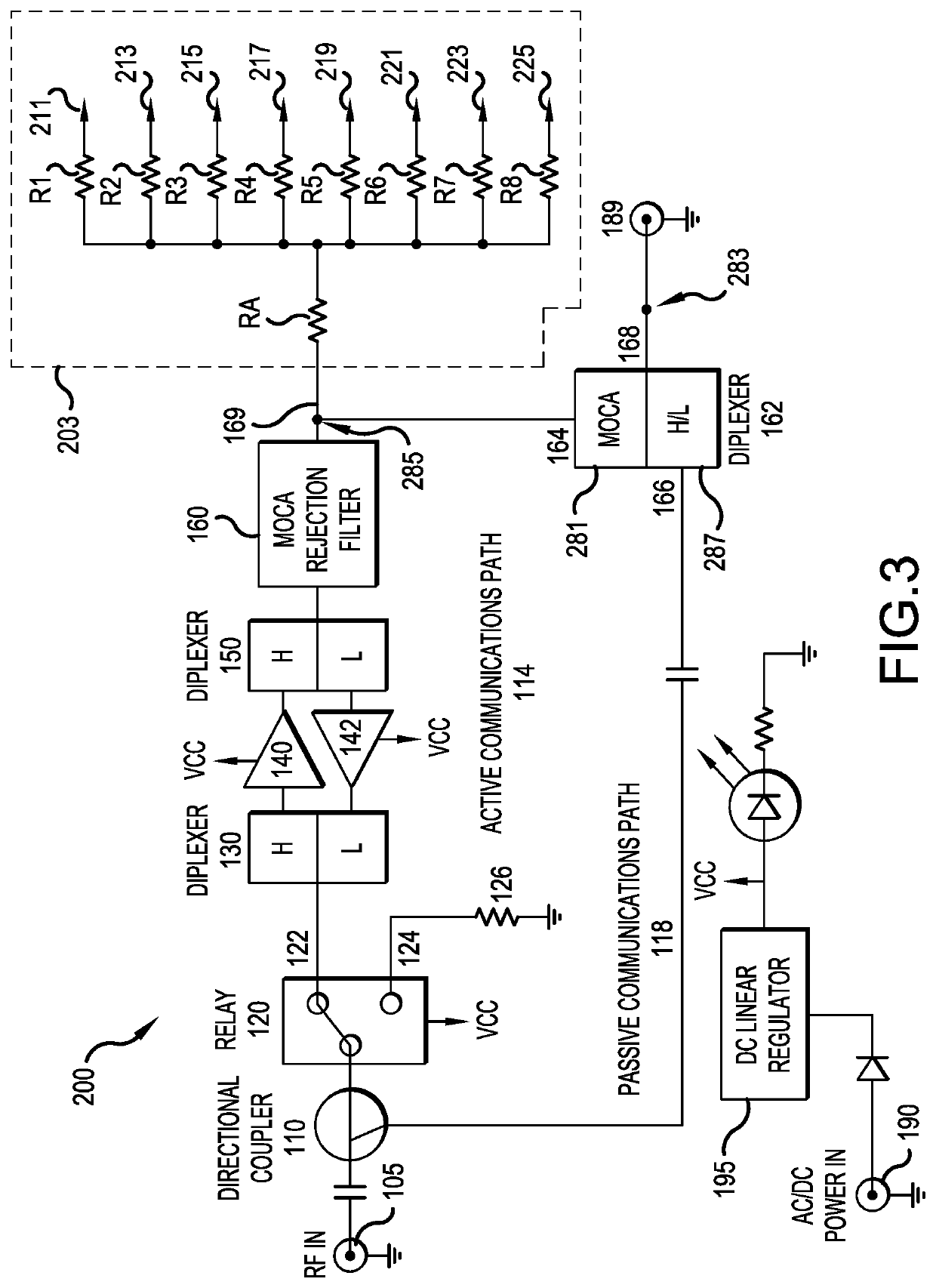CATV device with resistive signal distribution network
a resistive signal and catv technology, applied in the field of radio frequency (“ rf”) signal amplifiers, can solve the problems of occupying significant area on the printed circuit board, relatively expensive passive devices such as power dividers, and relatively expensive elements, so as to reduce surface area requirements, increase volume, and reduce surface area
- Summary
- Abstract
- Description
- Claims
- Application Information
AI Technical Summary
Benefits of technology
Problems solved by technology
Method used
Image
Examples
first embodiment
[0051]FIG. 3 is a block diagram of a CATV bi-directional RF signal amplifier 200, according to the present invention. The CATV RF amplifier 200 includes many of the same or similar elements, as compared to FIG. 1, and these elements have been labeled by the same reference numerals.
[0052]The CATV RF amplifier 200 is enclosed by a housing 101. In particular, the housing 101 may be the same as depicted in FIG. 2, although the dimension (length, width and thickness) may be slightly reduced due to the smaller components.
[0053]A RF input port 105 is located on the housing 101. The input port 105 receives downstream service provider signals and transmits upstream signals from customer devices to the service provider. As in the background art, the RF amplifier 200 includes a first or upstream diplexer 130 having a full frequency band terminal, a high frequency band terminal and a low frequency band terminal. The full frequency band terminal is connected to the input port 105, via a relay 12...
second embodiment
[0061]FIG. 4 is a block diagram of a CATV bi-directional RF signal amplifier 300, according to the present invention. The CATV RF amplifier 300 is identical to the CATV RF amplifier 200 of FIG. 3, except that the first and second diplexers 130 and 150 have been replaced by upstream and downstream directional couplers 301 and 303. The upstream and downstream directional couplers 301 and 303 in combination with the first and second amplifiers 140 and 142 form a full duplex amplifier, which will be briefly described below. More details concerning the full duplex amplifier can be found in the Assignee's co-pending application Ser. No. 62 / 740,550, which is herein incorporated by reference.
[0062]The full duplex amplifier has an upstream directional coupler 301. The upstream directional coupler 301 has a first terminal 11, a second terminal 13 and a third terminal 15. Signals passing between the first and third terminals 11 and 15 in either direction encounter a first level of attenuation....
third embodiment
[0068]In the embodiments of FIGS. 3 and 4, the resistive splitter network 203 includes only resistors. FIG. 5 is a block diagram of a CATV bi-directional RF signal amplifier 400, according to the present invention. The CATV RF amplifier 400 is identical to the CATV RF amplifier 200 of FIG. 3, except that the resistive splitter network 203 has been replaced with a modified resistive splitter network 403.
[0069]The modified resistive splitter network 403 includes a power divider 171 with a ferrite core to split an incoming signal received at an input leg 407 to two output legs 409 and 411. The power divider 171 also uses the ferrite core to combine signals received at the two output legs 409 and 411 to send the combined signal to the input leg 407.
[0070]A first plurality of resistors RA, R1, R2, R3 and R4 are connected to the first output leg 409 and are connected to first, second, third and fourth RF output ports 211, 213, 215 and 217. A second plurality of resistors RB, R5, R6, R7 an...
PUM
 Login to View More
Login to View More Abstract
Description
Claims
Application Information
 Login to View More
Login to View More - R&D
- Intellectual Property
- Life Sciences
- Materials
- Tech Scout
- Unparalleled Data Quality
- Higher Quality Content
- 60% Fewer Hallucinations
Browse by: Latest US Patents, China's latest patents, Technical Efficacy Thesaurus, Application Domain, Technology Topic, Popular Technical Reports.
© 2025 PatSnap. All rights reserved.Legal|Privacy policy|Modern Slavery Act Transparency Statement|Sitemap|About US| Contact US: help@patsnap.com



